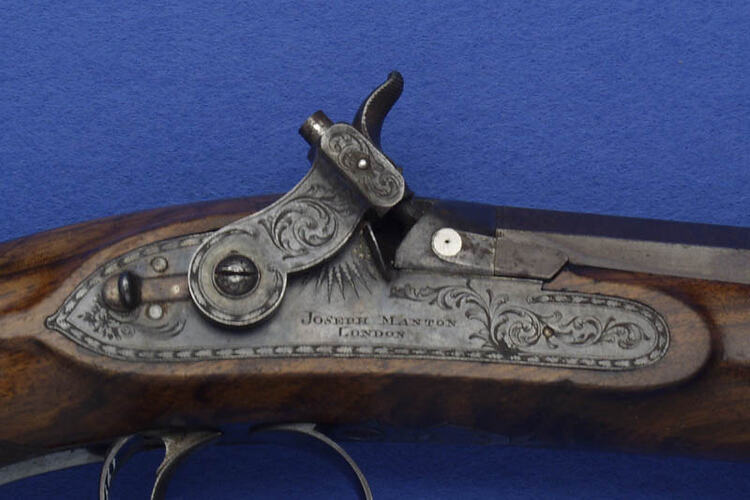The name of Manton is one of the most well-known names associated with the English gun trade during the late eighteenth and early nineteenth century. Described in an epitaph written by Colonel Peter Hawker for his tomb as 'The greatest artist in firearms that ever the world produced', Joseph Manton, alongside his brother John, become internationally renowed for high quality and innovative developments within the trade.
Joseph Manton was born in April 1766 to John Manton and Mary Gildon and was baptised on the 29 April at St. Wulfram's. The scant details recorded in the family bible and the parish register are the only record of the first fifteen years of his life, although the churchyard of St. Wulfram's contains numerous members of the broader Manton family.
Between 1780-89 he was apprenticed first to a gunmaker in Grantham, Newton, before working under his elder brother John from 1781 onward, at 6 Dover Street, London.
At the age of 23 in 1789 Joseph moved out on his own and began experimenting with various improvements relating to rifling and wadding. His innovations caught the eye of those working at the Board of Ordnance and throughout the 1790s he was entertained by government patronage.
He married in 1792 Mary Ann Aitkens and in November of that year his first child was born and named after his sister-in-law, Susannah Aitkens. A son followed two years later in 1794 only to die in infancy, before another son, Joseph, was born in November 1795. He would later join his father in business. In all, nine children were born to Joseph and Mary Manton.
By the mid 1790s, Joseph Manton was producing about 100 weapons annually, including both cased duelling sets as well as fowling pieces - the precursor to what would become familiar in the form of the shotgun.
During the following five decades numerous names that would later become well-recognised figures within the London gunsmith trade passed through Manton's workshop as employees or were drawn upon by the business in the manufacture of parts, amongst them James Purdey and Charles Lancaster.
The business went bankrupt in 1826 and while it was revived temporarily across 1827-28 it too fell into debt, for which Manton was imprisoned between 1828-29.
Joseph Manton died on 29 June 1835 and in the abovementioned epitaph, Hawker wrote that while his tomb would mark only his mortal remains: 'an everlasting monument to his unrivalled genius is already established in every quarter of the globe by his celebrity as the greatest artist in fire arms ever the world produced, as the founder and the father of the modern gun trade, and as a most scientific inventor in other departments, not only for the benefit of his friends and the sporting world, but for the good of his King and Country.'
References:
Blackmore, H. (1986). A Dictionary of London Gunmakers, 1350-1850, Phaidon, Christie's, Oxford, England.
Neal, W. and Back, D. (1967). The Mantons: Gunmakers, Jenkins, London.
More Information
-
Keywords
-
Localities
-
Authors
-
Article types
